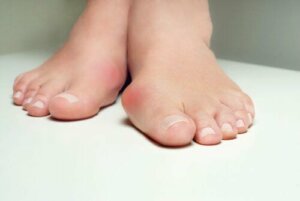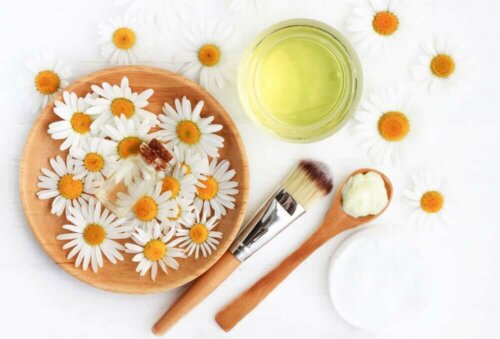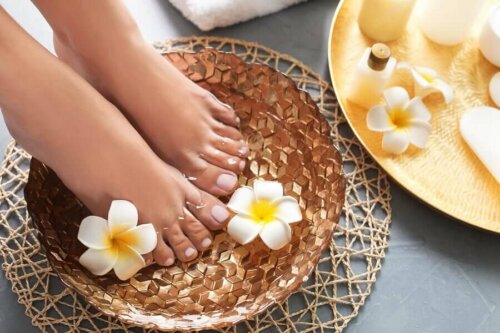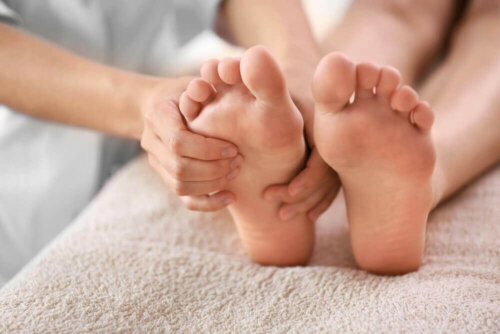Seven Effective Ways to Relieve Bunion Pain


Reviewed and approved by the doctor Nelton Abdon Ramos Rojas
Today’s article will discuss how to relieve bunion pain. These are deformities on your big toes that can be both painful and unsightly. Hallux valgus is the scientific name for this condition and it’s basically when excess bone builds up on your toe with a fluid-filled sac at the base.
Bunions are usually genetic. The deformity itself isn’t actually what is inherited, but rather the way of walking, or your gait.
To properly treat bunion pain and discomfort, it’s best to go to the doctor and follow their instructions. On the other hand, we recommend wearing comfortable shoes every day and maintaining a good lifestyle.
Seven home remedies to relieve bunion pain
In addition to keeping good habits and following your doctor’s recommendations, here are some popular home remedies to relieve bunion pain.
1. Chamomile

All you have to do is make a nice cup of tea and enjoy it before bed. Furthermore, others prepare poultices or apply chamomile ointments for relief.
2. Aspirin and olive oil
According to some beliefs crushing 3 tablets of aspirin and mixing them with warm olive oil will create an anti-inflammatory mixture, suitable for the relief of the discomfort caused by bunions.
It is usually recommended to apply and massage the area with gentle movements for at least 10 minutes.
Read about the Five Natural Anti-Inflammatory Treatments for Joint Pain
3. Localized exercise is great to relieve bunion pain
If you want to get relief from bunion pain, you can combine the above remedy with the following exercises:
- Firstly, seated, use your hands to move your toes back and forth for about 5 minutes. Do it gently, it shouldn’t hurt.
- Then, roll a ball with your foot for another 10 minutes. This is a good form of self-massage that relieves the pain.
4. Fig salt foot bath

Salt baths are great for the relief of foot discomfort, including bunions. Although coarse sea salt can be used, fig salt or magnesium sulfate can also be used.
- Dissolve one or two tablespoons of this salt in hot or warm water and soak your feet for at least 20 minutes a day to help reduce bunion pain.
- It’s best you do this at night so you can go to bed with alleviated feet.
5. Essential oils
Self-massages with anti-inflammatory essential oils can also be very useful. Chamomile essential oil is a good option, as it’s suitable for different skin types, although lavender and calendula are also often used.
Check out Why Bunions Form
6. Turmeric to relieve bunion pain
Turmeric’s special properties may help relieve bunion pain because they act as an anti-inflammatory. You can take it as a tea and enhance the effect by also applying it topically to your bunions.
Ingredients
- 1 tsp. of powdered turmeric
- 1 tsp. of one of the oils we mentioned above
Procedure
- Firstly, mix the two ingredients together and apply with a gentle massaging motion.
- Finally, remove with a towel and warm water.
7. Proper diet
Maintaining a balanced diet is essential for good health. But when it comes to relieving certain discomforts, we recommend including some foods with anti-inflammatory properties such as ginger, cinnamon, green tea, fruits, oats, vegetables, and greens, which can contribute to the relief of bunion pain.
You don’t have to eat them all at once, but do make an effort to eat a well-balanced diet that includes them.
How to prevent bunions

Follow these tips that may reduce your risk of getting bunions:
- Choose comfortable shoes. Try to wear shoes that fit well.
- See an orthopedist. They can tell you what kind of shoes to wear to help reduce your bunion pain and keep them from getting worse.
- Wear orthopedic inserts, padding made of silicon or other soft materials, customized insoles, and daytime or nighttime corrective devices.
- Apply hot and cold compresses. Hot-cold therapy can be a big help for bunions. Besides possibly helping relieve pain, it may also get your circulation going.
Remember that the most important thing is prevention. If you already know that bunions run in your family, you know that you’re likely to get them too.
It’s smart to pay attention to any kind of abnormality in your feet, such as pain, numbness, and reddening, and get checked out regularly by a podiatrist.
All cited sources were thoroughly reviewed by our team to ensure their quality, reliability, currency, and validity. The bibliography of this article was considered reliable and of academic or scientific accuracy.
- Berger, M. R. (1984). Bunions. Orthopaedic Nursing, 3(5), 17–24. https://doi.org/10.1097/00006416-198409000-00003
- Bunion: Strengthening Foot Muscles to Reduce Pain and Improve Mobility. (2016). Journal of Orthopaedic & Sports Physical Therapy, 46(7), 606–606. https://doi.org/10.2519/jospt.2016.0504
- Hart, E. S., Deasla, R. J., & Grottkau, B. E. (2008). Current concepts in the treatment of hallux valgus. Orthopaedic Nursing, 27(5), 274–280. https://doi.org/10.1097/01.NOR.0000337276.17552.1f
- Maroto, M. R., Park, D. K., & Lee, S. (2012). Hallux Valgus (Bunion). In Essential Orthopaedics(pp. 776–780). Elsevier. https://doi.org/10.1016/b978-1-4160-5473-3.00185-4
- Sell, C. (2015). Chemistry of essential oils. In Handbook of Essential Oils: Science, Technology, and Applications, Second Edition (pp. 165–194). CRC Press. https://doi.org/10.1201/b19393
- Chainani-Wu, N. (2003). Safety and Anti-Inflammatory Activity of Curcumin: A Component of Tumeric ( Curcuma longa ) . The Journal of Alternative and Complementary Medicine, 9(1), 161–168. https://doi.org/10.1089/107555303321223035
This text is provided for informational purposes only and does not replace consultation with a professional. If in doubt, consult your specialist.








